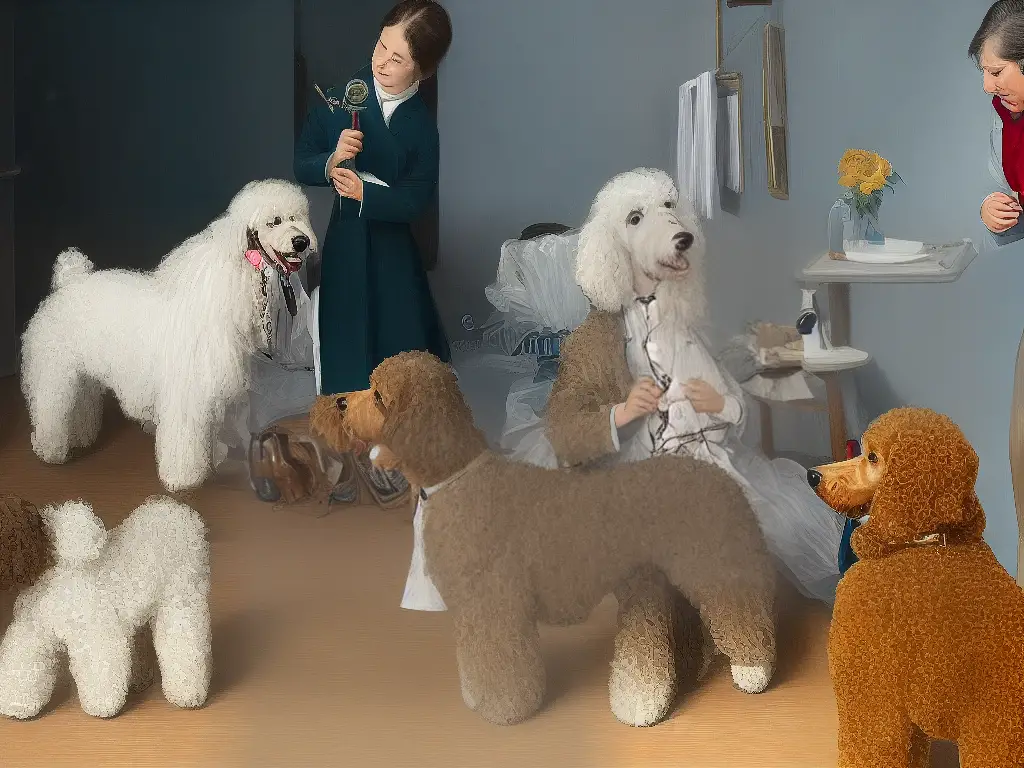Poodle Allergies: Common Allergies and How to Treat Them
Poodle allergies can be a significant concern for dog lovers and prospective pet owners, as they can result in discomfort and health issues. This essay delves into understanding the causes and symptoms of poodle allergies, how they differ from other dog breed allergies, and how they can be prevented or managed. Additionally, this essay will explore the concept of hypoallergenic dog breeds, treatment options available for those who suffer from poodle allergies, and practical tips for living with a poodle allergy.
Understanding Poodle Allergies
Poodle allergies are a significant concern for dog lovers who suffer from allergic reactions to pets, particularly dogs. Many people with dog allergies express an interest in poodles because they are often described as a hypoallergenic breed. Understanding the causes of poodle allergies and the role of allergens is important to make informed decisions when it comes to adopting and owning a poodle.
Allergies to dogs are typically caused by proteins found in a dog’s skin cells, urine, and saliva. These proteins are considered allergens and can trigger a reaction in some individuals. In the case of poodles, the most common cause of an allergic reaction is pet dander – small particles of dead skin cells that are shed by the dog. The unique curly coat of poodles can help to reduce the spread of pet dander, making them less likely to cause an allergic reaction in comparison to other breeds. However, this does not guarantee that poodles are completely hypoallergenic or suitable for everyone with dog allergies.
It’s important to note that poodle allergies can also be caused by other allergens besides pet dander. Some individuals may have a sensitivity to proteins in a poodle’s saliva or urine, which can still cause an allergic reaction. Additionally, environmental factors such as pollen, dust, and mold can exacerbate allergy symptoms, making it difficult to pinpoint the exact cause.
Poodle allergies differ from other dog breed allergies mainly due to their distinctive coat. Poodles have a dense, curly coat that is much less prone to shedding than other breeds. This characteristic helps to reduce the dispersion of allergens into the environment, making them a more favorable option for those with dog allergies. However, it is essential to remember that no breed is completely hypoallergenic, and individual reactions to allergens can vary greatly.
In conclusion, while poodles may be a better option for individuals with dog allergies due to their low-shedding coat, it is essential to recognize that the breed is not entirely hypoallergenic. Poodle allergies can still occur due to allergens found in pet dander, saliva, and urine.

Symptoms and Diagnosis
If someone is considering owning a poodle and has a history of allergies, it is crucial to spend time around poodles to gauge their personal reaction and consult with an allergist before making a decision. Poodle allergies, much like other dog allergies, manifest as a range of symptoms that affect both the dog and its owner. It is vital for pet owners to recognize these signs and symptoms in order to provide the best care possible for their poodle.
Some common symptoms experienced by the dog include excessive itching and scratching, hair loss, red and inflamed skin, recurrent skin infections, and persistent ear infections. These symptoms are typically caused by the dog’s immune system reacting to allergens, which can include environmental factors like pollen, mold, and dust mites, as well as allergens found in food or flea bites.
On the other hand, human owners may experience allergic reactions to their poodle’s dander, which is composed of tiny skin cells and hair particles. When these allergens become airborne, they can cause an allergic response in sensitive individuals. Common symptoms in humans include a runny or stuffy nose, sneezing, itchy and watery eyes, coughing, and rashes on the skin. It should be noted that poodles are often considered hypoallergenic due to their low-shedding coats, but no dog breed is truly allergen-free.
Diagnosing Poodle Allergies
In order to accurately diagnose a poodle allergy, a veterinarian will conduct several tests.
Firstly, a thorough physical examination will be done to look for any visible signs of allergies. The vet may also ask about the dog’s history and environmental factors to help determine any triggers or patterns.
Skin tests are a common method used by veterinarians to diagnose environmental allergies. During the skin test, small amounts of common allergens are injected under the skin to see if the dog has a reaction. Blood tests can also be done to measure the dog’s immune response to certain allergens, which can aid in detecting food allergies.
Another useful diagnostic tool is the elimination diet, which may be recommended if a food allergy is suspected. This involves removing potential allergens from the dog’s diet and slowly reintroducing them one by one to determine which ingredient causes a reaction. It is important to work closely with your veterinarian when performing an elimination diet to ensure that your dog’s nutritional needs are met throughout the process. The vet may also suggest using hypoallergenic dog foods during this time.
To accurately identify and manage the underlying causes of poodle allergies, it is essential to approach the diagnostic process with diligence, patience, and the guidance of a veterinary professional. In some cases, veterinarians may need to run additional tests to rule out other potential causes of the allergy symptoms, such as infections, hormonal imbalances, or even autoimmune disorders. Poodle allergies can have multiple triggers and may overlap with other health conditions, making the diagnostic process crucial.

Prevention and Management
With proper diagnosis, one of the primary aspects to manage and prevent poodle allergies is grooming. Poodles are known for their curly, hypoallergenic coats that produce minimal dander, but regular grooming is essential to maintain a clean and healthy coat. Brush your poodle daily to prevent the hair from matting and remove any loose hair and dander. It is recommended to have a professional groomer trim your poodle’s coat and give them a thorough bath using hypoallergenic shampoo every 4-6 weeks. Additionally, remember to keep up with ear cleaning and dental care, as allergies can be triggered by bacteria and debris in these areas.
Diet is another vital factor in minimizing poodle allergy triggers. Feeding your poodle high-quality, hypoallergenic dog food can help reduce the amount of allergens they produce. Look for dog food with limited or natural ingredients and avoid common allergens such as corn, soy, and wheat. Adding supplements like omega-3 fatty acids and probiotics to your poodle’s diet can help improve their skin and gut health, further reducing the likelihood of allergies. Be sure to consult with your veterinarian before making any dietary changes or adding supplements to your poodle’s diet.
The environment that your poodle lives in can also greatly impact the prevalence of allergens. Keeping your home clean and free from dust, mold, and other allergens can provide relief for both you and your poodle. Regularly vacuum your home, including furniture and upholstery your poodle frequents, to remove pet dander and hair. Use an air purifier with a HEPA filter to reduce allergens in the air. Wash your poodle’s bedding weekly with hypoallergenic detergents to eliminate any allergens that may be lurking there.
Allergy testing is another consideration for managing poodle allergies. If you are unsure about the cause of your allergies, it might be helpful to undergo allergy testing. It can provide insights into specific allergens causing your symptoms and guide you on necessary precautions. If it turns out that you are allergic to poodle dander or saliva, speak with your veterinarian about possible allergy shots or medication to help manage your symptoms.
Poodles are among the most prominent hypoallergenic breeds due to their unique hair coat type and low shedding. The science behind hypoallergenic dogs lies mainly in their coat type, the amount of allergens they release, and how often they produce these allergens. Nonetheless, it is essential to take extra measures in managing your poodle to prevent allergies in sensitive individuals.

Hypoallergenic Breeds and Crossbreeds
One effective approach to manage poodle allergies is training your poodle to avoid certain areas in your home, which helps in preventing allergy triggers. Establish designated pet-free zones, particularly in your bedroom, to create a safe space for those with allergies. Consistent training and positive reinforcement will help your poodle understand and respect these boundaries, reducing the chances of allergens spreading throughout your home. Additionally, keeping your poodle well-exercised and mentally stimulated can minimize their shedding, thus reducing the amount of allergens they produce.
The major allergen in dogs is the protein Can f 1, which is found in their skin cells, urine, and saliva. Hypoallergenic dogs either produce less of this protein or shed less dander and hair containing this protein compared to other breeds.
Poodles, both standard and miniature, are popular hypoallergenic dogs thanks to their curly, dense, and low-shedding coats. They are known for minimal dander and don’t release much canine allergen into the environment. Their coats require regular grooming to prevent matting, which can be beneficial for allergy sufferers, as grooming can also help reduce allergen levels. Moreover, Poodles are intelligent, friendly, and highly trainable, making them an attractive option for people with allergies who desire a pet.
Crossbreeds involving hypoallergenic breeds, such as Poodle mixes, are also a popular option for allergy sufferers. Labradoodles, a mix between a Labrador Retriever and a Poodle, and Goldendoodles, a mix between a Golden Retriever and a Poodle, are both common examples. These crossbreeds often inherit the low-shedding and low-dander characteristics of the Poodle parent, making them more suitable for people with allergies. However, it is important to note that not all Poodle mix puppies will inherit these hypoallergenic traits. Allergen levels can vary even within a litter, so it’s crucial to spend time with a prospective puppy to determine how it affects one’s allergies.
Other hypoallergenic breeds and crossbreeds include the Bichon Frise, Maltese, and the Schnauzer. These breeds also have low-shedding coats and produce less dander, reducing the chance of causing an allergic reaction. Each breed has its own unique personalities and grooming requirements, so it is important to research and spend time with individual dogs to determine which breed is the best fit for one’s lifestyle and allergy level.
No dog breed is truly 100% allergen-free, but certain breeds and crossbreeds, like Poodles and their mixed breeds, can be a better option for those with mild to moderate allergies. It is important to understand that hypoallergenic does not mean allergen-free, but it refers to dogs that produce fewer allergens compared to other breeds. By spending time with different hypoallergenic breeds and closely monitoring one’s reactions, it is possible to find a suitable dog for individuals with allergies.

Medical Treatment Options
For people who experience poodle allergies, one common medical treatment option is allergy shots, also known as allergen immunotherapy. This treatment involves injecting small amounts of the allergen, such as proteins found in a dog’s skin cells and urine, into the individual’s body over time to gradually build up a tolerance. Ultimately, this reduces the intensity of allergic reactions. The initial phase of therapy usually involves receiving injections once or twice a week, followed by monthly maintenance injections that can last for several years. It’s crucial to consult an allergist to determine if allergy shots are an appropriate treatment option for you.
Another medical treatment alternative for poodle allergy sufferers is the use of over-the-counter or prescription medications, depending on the severity of the symptoms. Antihistamines, such as cetirizine, loratadine, and fexofenadine, work by blocking the effects of histamine, a chemical released by the immune system during an allergic reaction. This results in a reduction of symptoms like sneezing, itching, and congestion. Decongestants, such as pseudoephedrine and phenylephrine, help relieve nasal congestion by narrowing the blood vessels in the nasal passages. Nasal corticosteroids, like fluticasone and triamcinolone, are prescription medications that can reduce inflammation and swelling in the nasal passages, ultimately alleviating allergy symptoms.
Alternative therapies for poodle allergies include natural remedies and lifestyle changes that can help alleviate symptoms and improve overall health. Quercetin, a natural supplement derived from fruits and vegetables, has been shown to have antihistamine and anti-inflammatory properties, potentially reducing allergy symptoms. Butterbur, another herbal supplement, has been found to be effective in reducing nasal symptoms associated with allergies. Additionally, incorporating a healthy diet, regular exercise, and stress management techniques can help boost the immune system and potentially reduce the severity of allergic reactions.
Air purifiers and HEPA filters can also be helpful in managing poodle allergies, as they minimize the presence of airborne allergens within the home environment. HEPA (high-efficiency particulate air) filters can eliminate up to 99% of airborne allergens, including pet dander. Using air purifiers equipped with HEPA filters can help in reducing the level of allergens in the air, thus decreasing the risk of experiencing allergy symptoms. Furthermore, it’s essential to maintain a clean living space by vacuuming, dusting, and washing linens and clothing regularly to reduce the buildup of pet dander and other allergens.
Poodle allergies are often a concern for people who are sensitive to dander, or pet-related allergens. Although Poodles are considered hypoallergenic due to their tight, curly hair, it is essential to understand that no dog is truly allergen-free. Nevertheless, by implementing some practical tips and advice, it is possible to live harmoniously with a poodle even if you have allergies.

Living with Poodle Allergies
In some cases, a more integrative approach to treating poodle allergies may be necessary, combining conventional medical treatments with alternative therapies. For example, acupuncture, a traditional Chinese medicine practice, has been found to help alleviate allergy symptoms in some individuals. Additionally, some allergy sufferers have found relief through biofeedback, a technique in which a person learns to control their bodily processes, such as heart rate and muscle tension, to reduce symptoms. It’s essential to discuss these alternative treatment options with a healthcare professional to determine their appropriateness and potential efficacy for your specific situation.
Managing the symptoms of a poodle allergy effectively requires adopting a multi-faceted approach. Regular grooming of your poodle should be prioritized as it helps minimize the presence of allergens in the environment. Poodles should be bathed every four to six weeks to wash away dander and loose hair. Regular brushing is also vital in preventing matting and spreading allergens. In addition, keeping your home clean can help alleviate allergy symptoms. Vacuuming carpets and upholstered furniture regularly with a vacuum cleaner equipped with a HEPA filter can reduce the presence of allergens significantly.
To create a comfortable home environment for individuals with poodle allergies, it is essential to limit the areas where the dog is allowed. Designate specific areas or rooms as pet-free zones, particularly bedrooms or living areas where allergic individuals spend significant time. Keeping your living space well-ventilated can help to disperse allergens throughout the home, reducing the concentration in particular areas. Air purifiers with HEPA filters are recommended to manage airborne allergens effectively.
Washing and maintaining bedding regularly is crucial when living with poodle allergies. Encase mattresses, box springs, and pillows in allergen-proof coverings and wash your bedding regularly in hot water. It is also helpful to use hypoallergenic materials for bed linens and reduce the number of plush or soft surfaces in your home that can trap allergens. Pay attention to flooring choices: hardwood and tile floors are easier to clean and less likely to accumulate allergens than carpets.
Lastly, regular allergy testing and treatment can help keep symptoms at bay. Depending on the severity of the allergies, medical treatments such as over-the-counter antihistamines or prescription medications may be necessary to alleviate symptoms. Regular consultations with an allergist and building awareness about triggers can help manage allergen exposure for a comfortable living experience with your poodle. By following these practical tips and advice, living with poodle allergies can become more manageable and enjoyable for all members of the household.

It is essential for dog lovers and pet owners to be knowledgeable about poodle allergies to ensure the well-being of both the dogs and their human companions. By understanding the causes, symptoms, prevention, and management strategies, as well as being informed about hypoallergenic breeds and medical treatments available, individuals can better navigate life with poodle allergies. With proper care, attention, and precautionary measures, people suffering from poodle allergies can lead healthy, comfortable, and enjoyable lives with their beloved pets.
